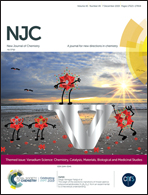The origin of the electronic transitions of mixed valence polyoxovanadoborates [V12B18O60]: from an experimental to a theoretical understanding†
Abstract
Mixed-valence polyoxovanadates (POVs) constitute a family of polyoxometalates whose electronic properties are still unclear. Polyoxovanadoborates (POVBs), a subfamily of POVs, show different electronic and magnetic properties compared to those of POVs. Upon the interpretation of the electronic spectra of these compounds, only three bands in the 350–800 nm range were reported in the literature. This is the first theoretical study of the electronic spectra of the [V12B18O60] family, and we showed that these three bands are the contributions of different excitations, i.e., LMCT + IVCT, d–d + IVCT and d–d + IVCT. We showed experimentally that in the NIR region, up to 1800 nm, IVCT transitions appear, whose intensity is dependent on the mixed-valence ratio. We also showed that the condensation of borate groups resulted in the loss of the differentiation of the vanadyl stretching vibration that depends on the oxidation state, which is as expected for other types of polyoxovanadates. This feature was proposed as a probe to observe the delocalized to localized phase transition in POVs.
![Graphical abstract: The origin of the electronic transitions of mixed valence polyoxovanadoborates [V12B18O60]: from an experimental to a theoretical understanding](/en/Image/Get?imageInfo.ImageType=GA&imageInfo.ImageIdentifier.ManuscriptID=C9NJ02549A&imageInfo.ImageIdentifier.Year=2019)
- This article is part of the themed collection: Vanadium Science: Chemistry, Catalysis, Materials, Biological and Medicinal Studies


 Please wait while we load your content...
Please wait while we load your content...